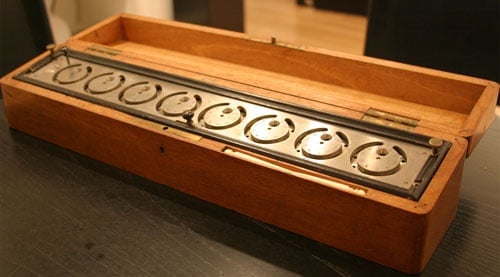Four Facts About Tito Gonnella’s Adding Machines

- Tito Gonnella invented a dial adder and keyboard adding machine.
- His keyboard adder made some improvements on the design and is known as one of the seventh keyboard-driven machines.
- He received a bronze medal at the 1851 London International Exhibition for his keyboard adding machine.
- Tito Gonnella is also known as the inventor of a reflecting telescope, first presented in 1841.
Tito Gonnella’s Adding Machines History

The dial adder was designed for simple calculations and was prone to jamming.
The Italian scientist and inventor Tito Filippo Gonnella (1794–1867), professor of mathematics and mechanics at the Florentine Accademia di Belle Arti di Firenze, is primarily known as the inventor (in 1824) of one of the first planimeters in the world. He’s also known for his work on other inventions, like an improved reflecting telescope in 1841.

Tito Gonnella created two adding machines that are still significant in the history of calculators: a dial adder and a keyboard adder. The dial adder, or the wheel adding machine, was similar to an earlier invention by Pascal. Jean Lépine and Hillerin de Boistissandeau created similar machines in the 1720s, as did David Roth in the 1840s.
Quick Facts
- Created
- c. 1850s
- Creator
- Tito Gonnella
- Original Use
- Adding machine innovations
- Cost
- N/A
The keyboard adding machine is considered the seventh keyboard-driven machine built at the time. Some machines were invented and built in the United States, so there’s reason to believe Gonnella wasn’t aware of these. Others, however, were built in Europe and shown at the London International Exhibition, making it likely Gonnella was familiar with them.
Tito Gonnella’s Adding Machines: How They Worked

Both mechanical calculator devices came with some critical issues, but they are still significant devices in the history of calculating machines. Gonnella’s dial adder was a six-positional brass and iron device contained in a wooden box. It used a pen to enter the numbers. While it worked for many simple calculations, the unique tens carry transfer mechanism was prone to jamming. This continued even after Gonnella created an anti-jamming device.
The solid brass-iron keyboard adder used a nine-digit keyboard and a helical drum for the accumulator. It wasn’t as fast as other adding machines of its time and required users to add a single digit at a time. The keyboard keys were attached to sectors with the corresponding number of teeth. This allowed each key to rotate the correct dial the appropriate revolutions to perform the calculation.
Tito Gonnella’s Adding Machines: Historical Significance

While both mechanical calculator inventions were innovative, they didn’t offer the practicality they needed to be commercial successes. Both of Tito Gonnella’s adding machines were subject to key issues. The dial adder tended to jam during ripple carry cases. For example, when the user tried to add one to 9,999.
The keyboard adder needed a mechanism for resetting the drum and a spring-driven arm to prevent the wheels from recoiling. It could also use a five-key design to streamline the machine. A five-key keyboard would have keys that could be pressed two in a sequence to add digits greater than five.
Background of Tito Gonnella
Tito Filippo Giovanni Battista Gonnella was born in Livorno, Italy, on September 18, 1794 to Francesco Gonnella and Violante Stoppioni. Francesco Gonnella’s father was a Doctor of Law from the University of Pisa, and was one of multiple publishers of the Livornese edition of Encyclopédie ou Dictionnaire Raisonné des Sciences, des Arts et des Métiers of Diderot and d’Alembert. Francesco followed in his father’s footsteps, also earning a doctorate degree in Pisa, and served in public administration as an assistant director of the archive of Libro detto delle Riformagioni in Livorno.
Tito Gonnella also received a Doctor degree from the University of Pisa in 1818. From there, was brought on as a professor of mathematics and mechanics to the Academy of Fine Arts of Florence in 1829. In 1841, he participated in the Third Congress of Italian Scientists, where he made a presentation of improvements that could be made to the Newtonian telescope. Tito Gonnella was also employed by the Museo di Fisica e Storia Naturale as an instrument-restoration consultant.
Up Next…
- Mechanical Calculators Explained — Everything You Need To Know The calculator was an invention that revolutionized arithmetic. Learn about the mechanics of it.
- The 6 Largest Computer Monitors You Can Buy Today If the size of a computer monitor is important to you, check out the 6 largest models you can purchase on the market.
- Steam Man of Zadoc Dederick Explained — Everything You Need To Know Learn about one of the earliest examples of a robot that operated on steam.
Want to Retire Early? Start Here (Sponsor)
Want retirement to come a few years earlier than you’d planned? Or are you ready to retire now, but want an extra set of eyes on your finances?
Now you can speak with up to 3 financial experts in your area for FREE. By simply clicking here you can begin to match with financial professionals who can help you build your plan to retire early. And the best part? The first conversation with them is free.
Click here to match with up to 3 financial pros who would be excited to help you make financial decisions.